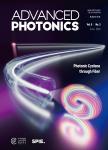Nanopolaritonic second-order topological insulator based on graphene plasmons
Nanopolaritonic second-order topological insulator based on graphene plasmons作者机构:Cornell UniversityDepartment of PhysicsIthacaNew YorkUnited States Cornell UniversitySchool of Applied and Engineering PhysicsIthacaNew YorkUnited States
出 版 物:《Advanced Photonics》 (先进光子学(英文))
年 卷 期:2020年第2卷第4期
页 面:47-54页
核心收录:
学科分类:081702[工学-化学工艺] 07[理学] 070205[理学-凝聚态物理] 08[工学] 0817[工学-化学工程与技术] 080501[工学-材料物理与化学] 0805[工学-材料科学与工程(可授工学、理学学位)] 0702[理学-物理学]
基 金:supported by the U.S.Army Research Office(ARO)under Grant No.W911NF-16-1-0319 the National Science Foundation(NSF)under Grant Nos.DMR-1741788 and DMR-1719875 support from the Kwanjeong Fellowship from the Kwanjeong Educational Foundation
主 题:graphene plasmons higher-order topological insulator nanophotonics photonic crystal
摘 要:Ultrastrong confinement,long lifetime,and gate-tunability of graphene plasmon polaritons(GPPs)motivate wide-ranging efforts to develop GPP-based active nanophotonic *** of topological phenomena into such platforms will ensure their robustness as well as enrich their capabilities as promising test beds of strong light–matter interactions.A recently reported approach suggests an experimentally viable platform for topological graphene plasmonics by introducing nanopatterned gates—*** propose a metagate-tuned GPP platform emulating a second-order topological crystalline *** metagate imprints its crystalline symmetry onto graphene by modulating its chemical potential via field-effect *** on the gate geometry and applied voltage,the resulting two-dimensional crystal supports either one-dimensional chiral edge states or zero-dimensional midgap corner *** proposed approach to achieving the hierarchy of nontrivial topological invariants at all dimensions lower than the dimension of the host material paves the way to utilizing higher-order topological effects for onchip and ultracompact nanophotonic waveguides and cavities.



